 |
Flat port vs. dome port
By David Knight
In the early days of digital compact cameras (prior to about 2004) the majority of models on offer had zoom lenses with a maximum wide-angle setting equivalent to about f=35mm on the 35 mm stills format. This corresponds to a field-of-view (FOV) of 63° in air, which is about the maximum acceptable for use behind a flat port underwater if the optical degradations caused by the water-air boundary are not to be noticeable at moderate image enlargements. The coverage obtained underwater is then 46°, which can hardly be called wide-angle; but various manufacturers also brought-out wide-angle converters (so-called 'wet lenses') that could be mounted to the outside of the underwater housing, and these supplementary optics not only gave true wide-angle coverage, they could also correct for the chromatic aberration pincushion distortion due to the port (actually, they usually over-correct for pincushion distortion and display barrel distortion). Thus, with the aid of cute little polycarbonate housings, pioneered by Olympus and later followed by Canon, Sony, Fuji and Panasonic, underwater photography came of age, and people with compact cameras could match (or, frankly, improve upon) the results obtained using expensive Nikonos equipment.
Camera manufacturers however, will vy for commercial advantage; and while most consumers don't understand the specifications that matter (i.e., optical performance figures) they can be swayed by megapixels and super-zooms (i.e., by things that result in image files many times larger than is warranted by the actual information content, and lenses that give wide f-range at the expense of optical correction). The less extreme examples of cameras subject to this trend still constitute good designs however, and while the move away from the traditional 2.5× optical zoom to 4× or even 5× is cause for some trepidation, the in-air results are generally not too bad.
So it was that in 2004, Olympus brought out the C-5060 compact camera with a 35 mm equivalent focal length range of 27 to 110 mm, and a (non-underwater) wide-angle converter giving an equivalent focal length of 19 mm. This was quickly followed by the upmarket C-8080 compact, with a 2/3" (3.9× crop factor) CCD, a 28 - 140 mm equivalent zoom, and a wide converter giving the equivalent of f=22.4 mm. In both cases, the companion underwater housings had interchangeable ports, with a flat port for use with the built-in lens, and a wide-angle port allowing the camera to be used underwater with the wide converter fitted. Unfortunately, the wide-angle ports were also flat, and so, while suitable for above water photography in wet conditions, they gave spectacularly bad results underwater. Fortunately however, ikelite brought out housings with optional dome ports for both cameras, giving a sensible alternative. The author also set out to promote an excellent fix for flat-port users in the form of computer radial correction, although few were keen to take the trouble to use it.
The problem, of course, has not gone away. Many modern fixed-lens cameras zoom-out to 28 or even 24 mm, making it extremely difficult for wet lens designers to avoid vignetting while still prividing good edge resolution. Hence, for those interested in taking high-quality wide angle photographs (regardless of camera system) the following direct comparison of flat port vs. dome port should be instructive (even though the C-8080 camera used for the tests is no longer available).
Note: Angle of coverage (FOV) figures given below are nominal, i.e., on the picture diagonal when focused at infinity. Some loss of FOV occurs with a dome port due to lens extension, i.e., the lens must focus on a virtual image at a distance always less than 4 dome radii in front of the centre of curvature of the dome.
28mm lens and flat port
| Olympus
C-8080 (2/3" CCD) camera in PT-023 housing. Standard flat port. Full wide (f=7.1mm), 35mm equiv. f=28mm. Aperture as indicated on test card.  ISO
50 ISO
50  Illumination:
ikelite DS-125 with 4100.5 TTL slave sensor. Illumination:
ikelite DS-125 with 4100.5 TTL slave sensor. Nominal
underwater FOV = 54° (camera FOV = 75°) Nominal
underwater FOV = 54° (camera FOV = 75°) Corner
detail is full size, cropped from 3264 × 2448 pixel
image. Corner
detail is full size, cropped from 3264 × 2448 pixel
image. |
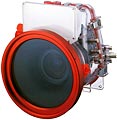 |
 ↔|
Distance
from test card to entrance pupil (estimated) = 0.58m
↔|
Distance
from test card to entrance pupil (estimated) = 0.58m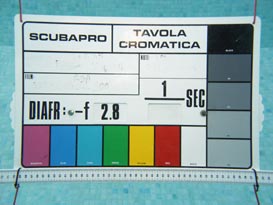 |
 |
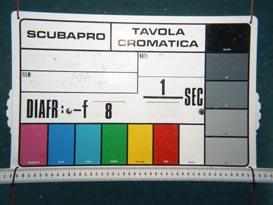 |
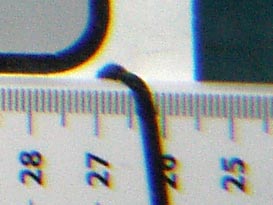 |
Radial Correction (removal of pincushion distortion and chromatic aberration). Same photographs as above, corrected in Adobe Photoshop using the Panorama Tools 3rd party filter plugin. The picture taken at f/2.8 (mixed lighting) has also been corrected for white balance.
 |
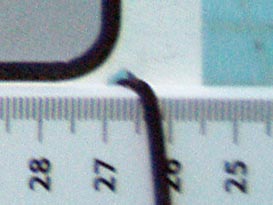 |
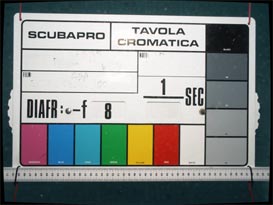 |
 |
| PanoTools Radial Correction Coefficients |
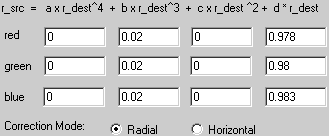 |
Chromatic aberration visible in the uncorrected pictures is almost entirely due to the air-water boundary and is unavoidable when using a lens with 75° coverage behind a flat port. It will be very noticeable in large prints and displays with significant edge detail.
The apparent degree of pincushion distortion is somewhat less than will be introduced by a flat port when the camera lens is rectilinear. This is because the C-8080 5× zoom shows some barrel (fisheye) distortion at the 28mm end of its range (see below). Most compact cameras, and many interchangeable zoom lenses, show barrel distortion at the wide setting, and so it could be argued that the flat port has a correcting effect. Chromatic aberration however, is a far worse defect than deviation from rectilinearity.
28mm lens and 6" dome port
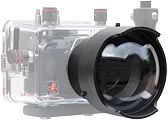 |
C-8080 camera in ikelite 6130.80 housing with 9306.38
dome
port. Full wide (35mm equiv f=28mm). Aperture as indicated on
test card. ISO
50 ISO
50  ikelite
DS-125 flash with diffuser & TTL sync cord. ikelite
DS-125 flash with diffuser & TTL sync cord. Dome
material: Acrylic, nD=1.492. Dome
material: Acrylic, nD=1.492. Inner radius: 76.2mm. Thickness: 5.54mm.  Nominal
UW FOV: ca. 75° Nominal
UW FOV: ca. 75° Corner
detail is cropped from 3264 × 2448 pixel image Corner
detail is cropped from 3264 × 2448 pixel image |
 ↔| Distance
from test card to entrance pupil (estimated) = 0.4m
↔| Distance
from test card to entrance pupil (estimated) = 0.4m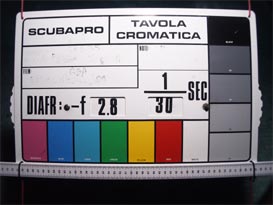 |
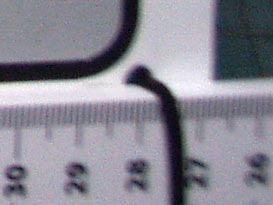 |
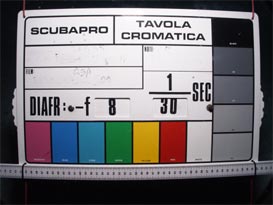 |
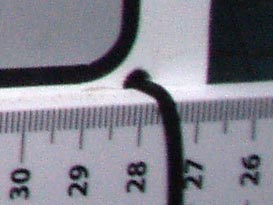 |
Radial Correction. Same photographs as above, corrected using PanoTools.
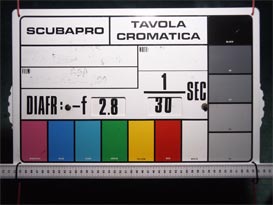 |
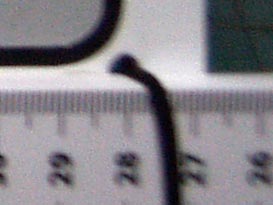 |
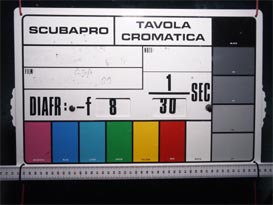 |
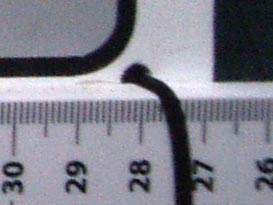 |
| PanoTools Radial Correction Coefficients dome port, full-wide zoom |
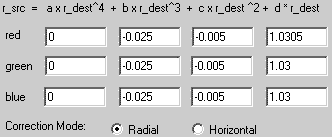 |
The original barrel (fisheye) distortion is due to the camera lens. The correction needed for chromatic aberration is negligible.
22.4mm lens and flat port
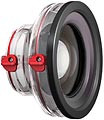 |
Olympus
C-8080 with WCON-08D 0.8× wide converter, in
PT-023
housing with PPO-05 wide (flat) port. Zoom at full wide,
equiv.
f=28×0.8=22.4mm. ISO
50 ISO
50  ikelite
DS-125 with 4100.5 TTL slave sensor ikelite
DS-125 with 4100.5 TTL slave sensor Nominal
UW FOV = 62.5° (Camera + WCON FOV in air = 88°) Nominal
UW FOV = 62.5° (Camera + WCON FOV in air = 88°) Corner
detail is cropped from 3264 × 2448 pixel image Corner
detail is cropped from 3264 × 2448 pixel image |
 ↔| Distance from test
card to entrance pupil (estimated) = 0.51m
↔| Distance from test
card to entrance pupil (estimated) = 0.51m |
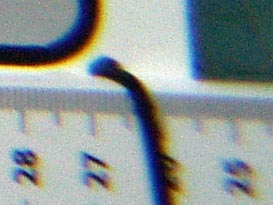 |
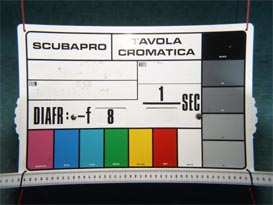 |
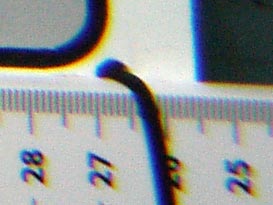 |
Radial Correction. Same photographs as above, corrected using Panorama Tools.
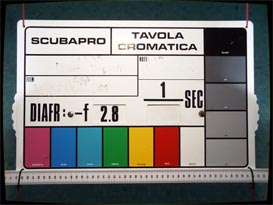 |
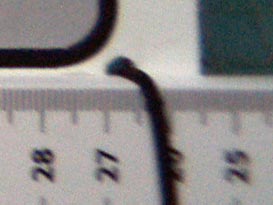 |
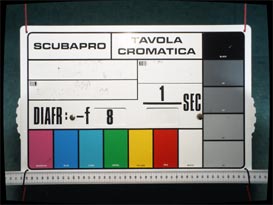 |
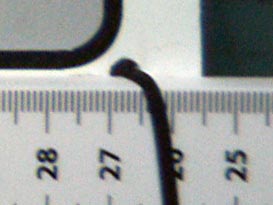 |
| PanoTools Radial Correction Coefficients |
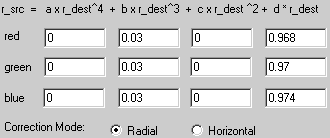 |
The addition of the wide conversion lens gives the C-8080 a nominal angle of coverage of 88° in air (equiv. f=22.4mm) and 62.5° underwater . The use of such a wide angle lens behind a flat port underwater results in a degree of pincushion distortion and chromatic aberration which will be noticeable even at small magnification. Hence, for underwater photography, software optical correction is almost essential.
22.4mm lens and 6" dome port
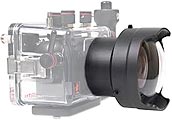 |
Olympus C-8080 with WCON-08D in ikelite 6130.80 housing with 9306.38 dome port.  ISO
50 ISO
50  ikelite
DS-125, diffuser, TTL sync cord. ikelite
DS-125, diffuser, TTL sync cord. Nominal
UW FOV: ca. 88° Nominal
UW FOV: ca. 88°  Corner
detail is cropped from
3264 × 2448 pixel image. Corner
detail is cropped from
3264 × 2448 pixel image. |
 ↔|
Distance from test card to entrance pupil (estimated) = 0.32m
↔|
Distance from test card to entrance pupil (estimated) = 0.32m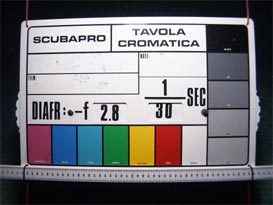 |
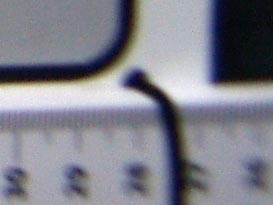 |
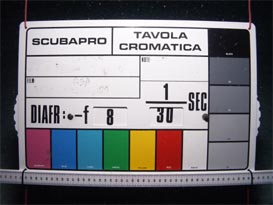 |
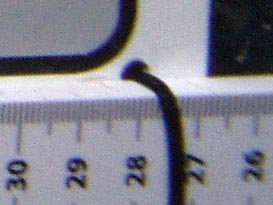 |
Radial Correction . Same photographs as above, corrected using Panorama Tools.
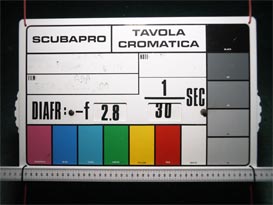 |
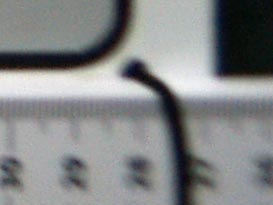 |
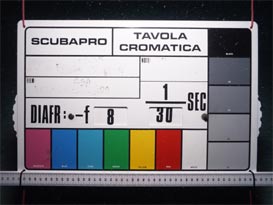 |
 |
| PanoTools Radial Correction Coefficients DP with WCON-08D, full-wide zoom. |
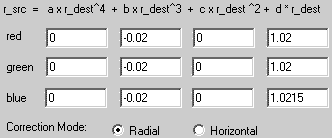 |
In practice
It could of course, be argued that test cards are intended to show-up optical defects, and that the inadequacies of the flat port will not be noticeable in practice. That this is not the case is illustrated by the picture below, which was taken using a 28mm lens (35mm format) behind a flat port.
The picture is of a moray eel hunting at night. It is somewhat cropped from the original because the animal was moving fast and careful composition was not possible. The image contains no straight lines, and so in the absence of geometric cues, there is no need to correct for pincushion distortion. Correction for chromatic aberration has however been applied, for reasons which become apparent from the corner detail images.
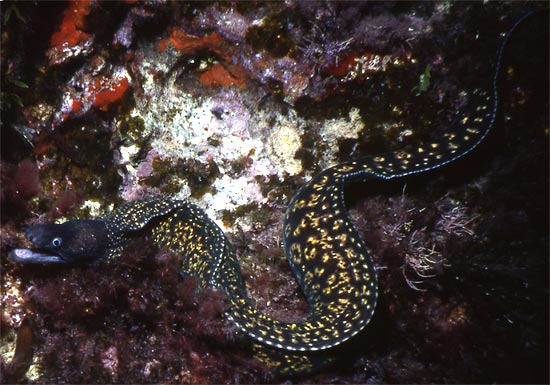
Corner detail cropped from 4335 × 2914 pixel image
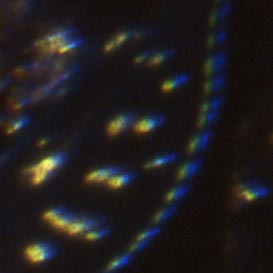 Uncorrected |
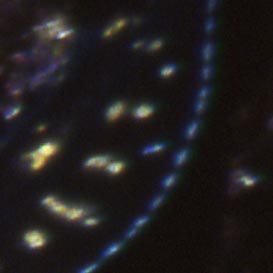 Corrected for chromatic aberration |
| Pano Tools radial
correction coefficients (chromatic aberration only - no geometric correction) |
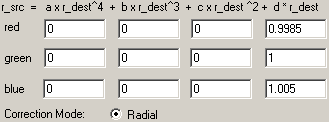 |
In the uncorrected picture, it can be seen that the red, green and blue images of fine detail on the animal's body have failed to superimpose. Such degradation is easily visible at moderate magnification.
Discussion
The main advantage of using a dome port in wide angle underwater photograpy is that the angle of coverage and overall image geometry of the main lens is conserved. Also we might add that, although some chromatic aberration is introduced at the air-water boundary, is is slight and barely noticeable in practice.
The flat port, on the other hand, introduces severe chromatic aberration and pincushion distortion; and while barrel distortion is sometimes considered desirable (i.e., when it is referred to as the 'fisheye effect'), pincushion distortion is only acceptable if it cancels existing barrel distortion.
After radial correction however, the flat port appears to produce better corner sharpness at large aperture (i.e., f/2.8) than does the dome. The reason is that the test card is flat, and the flat port focuses in a flat field; whereas the field of focus for the dome port is curved. Hence, to make the test card sharp at the corners when using a dome port, it is necessary to maximise the depth of field by stopping-down the lens.
The question is whether the curvature of field of the dome port optical system matters in practice. For the widest angle photographs given above (f=22.4mm with dome port), the distance from the entrance pupil to the test card is about 0.32m, i.e., the card is 24cm from the front of the port, which is very close. For most wide-angle photography applications, the distance will be greater and the field curvature problem will be much less severe.
Overall, we can commend the dome port as a device that allows the production of wide-angle underwater photographs without the need for further processing. The flatness of field of the flat port after radial correction may however be of interest for some types of scientific or technical photography.
One curious irony uncovered by this study is that the Olympus housing designers achieved nothing useful (from the end-user's point of view at least) by producing a flat port for the WCON-08D lens. Not only was the uncorrected image quality terrible, we can also note that the addition of the WCON increased the underwater FOV from 54 to 62.5°, whereas changing to a dome port (without fitting the WCON) increased the coverage to 75° with negligible optical degradation. Thus the dome port is a type of wide conveter in its own right; and a simple moulded acrylic hemisphere (albeit highly polished) radically exceeded the performance obtained using an exotic piece of ground multi-coated optical crown glass.
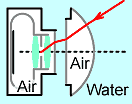 |
The fact that, in a world where flat ports are the norm, the dome on its own is a wide converter, has led some manufacturers to produce devices called 'dome converters' (see illustration left). These are more accurately described as plano-convex air lenses, being constructed as a section cut from a spherical dome, closed by a flat optical window, filled with air and sealed by one or more O-rings. |
 ikelite |
Wet mounting dome
converters (plano-convex air lenses) |
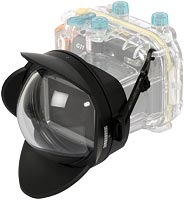 H2O Tools |
If the camera zooms-out to 28 or even 24 mm, one advantage that the dome converter has over the external multi-element wet lens is its very large rear optical aperture. This means that the system is unlikely to vignette.
DWK
© David W Knight. 2004, 2012. Updated Feb. 2018.
David Knight asserts the right to be recognised as the author of this work.